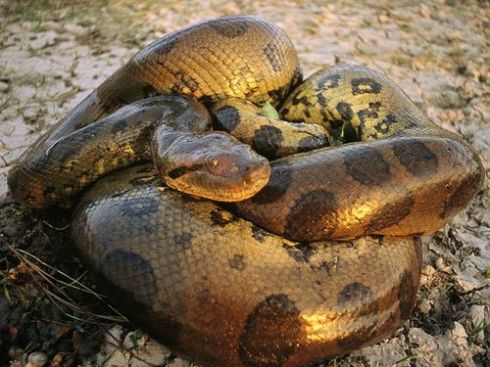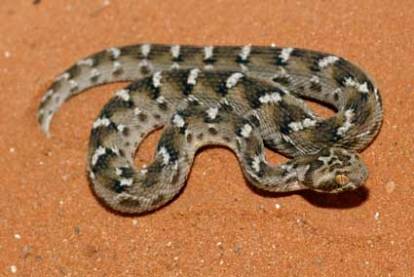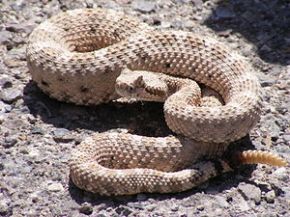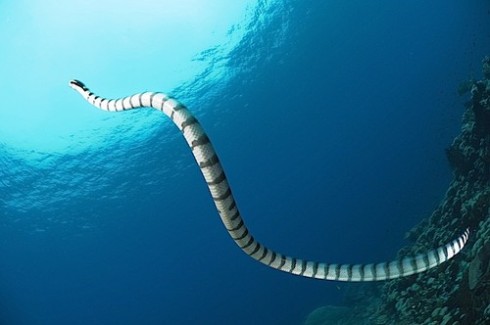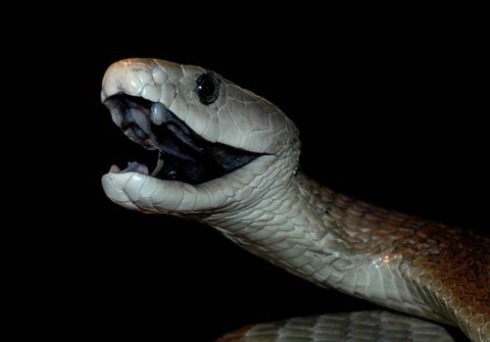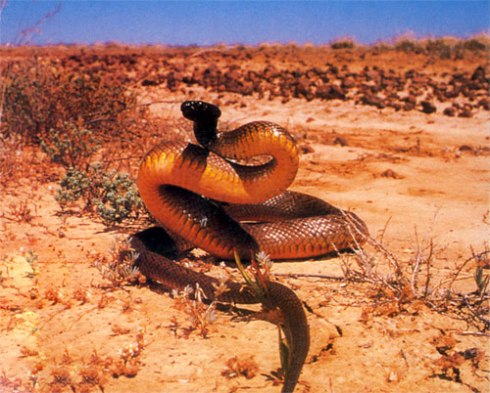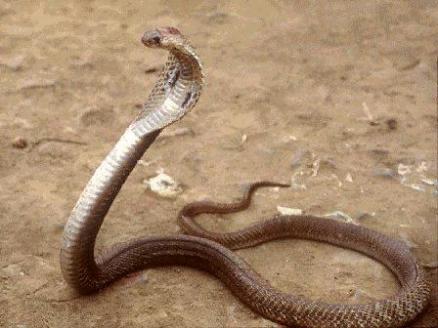10) Anaconda
Anacondas are monsters of the snake world, found in South America, they can reach lengths of up to 28 feet and weigh up to 450lbs, gaining its title as the largest snake in the world. Although articulated pythons can grow longer, the anaconda is still known as the largest due to its weight and width. It is easy to see why these monsters are so frightening to some people, with its large size giving a fully grown one approximately 9 feet for striking distance. Doesn’t leave much chance for prey to escape.
These snakes are constrictors and therefore do not kill with venom, but bind their prey with their huge muscular bodies and squeeze the life out of them. Their power is so great that even an alligator would do well to survive an attack from this creature. Often found in swamps, marshes and slow moving streams, anacondas are hunters both in and out of water. With their eyes and nostrils being on top of their heads they are able to lay and wait in water for prey, feeding on a diet of wild pigs, deer, birds, turtles, capybara, caimans, and even jaguars. Snakes have extremely stretchy ligaments in their jaws which enables them to swallow prey whole regardless of size, and a big meal can last them for weeks or even months.
9) Saw Scaled Viper
Native to Africa and Asia, don’t let this snakes size fool you, it is extremely aggressive. Though its venom is not as toxic as some other snakes higher up in this list, it is still a danger. Spending its days lurking below the sand with just its eyes showing, waiting for unsuspecting prey.
This snake gets its name through the noise it makes when it rubs its scales together giving warning to anything it may feel threatened by. Vipers can be identified by their pear shaped heads which appears different to many other snake species. As a species they are responsible for the most snake bites and subsequent deaths in the world. As for diets, there is limited knowledge as a vipers choice of meal can be so varied, including things such as; locusts, beetles, worms, slugs, spiders, scorpions, centipedes, frogs, toads, reptiles (including other snakes), small mammals and birds.
They may be small, but it would not be wise to tease this animal, after all size doesn’t matter. They can still deliver a nasty venomous bite.
8) Rattlesnake
This well known snake is another venemous killer, whose venom travels through the bloodstream of its victims, destroying healthy tissue and causing swelling, internal bleeding and extreme pain. A species known as the Mojave Rattlesnake, also as neurotoxins in its venom which causes paralysis and otehr complications of the nervous system. These snakes cause the most snake bite cases in North America and account for around 80% of fatalities.
The rattlesnake is common around North America, where they are protected by law, however they are still killed in their thousands. Their population in many areas is severely threatened due to habitat destruction, poaching and campaigns for extermination. They also are in danger of becoming prey themselves from the likes of large birds, weasels, skunks and other snakes.
Rattlesnakes kill their prey with a single venemous bite. After being bitten the prey is allowed to move away and when it dies the snake follows its scent using its powerful sense of smell. Odors emitted from the preys mouth indicated to the snake where the head is, so it can swallow its meal head first. This is so wings and/or limbs fold at the joints allowing easy swallowing.
Fear of the rattlesnake commonly comes from the noise that they create with the ends of their tails, which make a loud and creepy rattling sound, which is the reason for their name.
7) The Death Adder
The Death Adder is a sneaky creature. It gets its food by luring its predators into a trap using its tail to trick unsuspecting prey into thinking its a worm.
This snake is native to Australia. Australia is a country I have always wanted to visit, and I plan to someday on a working holiday with my girlfriend. Australia has such a great range of reptiles that I would love the oppertunity to work with, experience like that would be invaluable. I first got an interest in this type of animal from growing up watching Steve Irwin as the Crocodile Hunter.
These adders grow to a length of 70-100 cm, and are not endangered, though they pose a great danger to other animals and humans. Their poison is so powerful that it can make many kills with one dose. With its long fangs, the death adder has the fastest strike among all venomous snakes in Australia. Its venom causes paralysis and often death.
You can find these snakes (although it would be wise not to go looking) in forests, woodlands, grasslands and heaths on the East coast of Australia. They are however hard to spot, with such effective camouflage with its band stripes, it can hide very well under leaves ect in woodland.
6) Reticulated Python
From Southeast Asia, the reticulated python is the worlds longest snake and reptile, and is on this list, although usually not being known as a danger to humans, it is perfectably capable of swallowing one of us whole, and there have been reports of this happening.
Pythons are constrictors and therefore do not posess venom, however their killing ability is not affected by this. Its long body that can grow up to 6m in length is filled with incredibly strong muscles for binding power.
These snakes can be found in rain forests, woodlands and grasslands, but due to its impressive swimming ability, it can also be found in nearby streams and lakes. In addition to this it has actually been reported far out to sea on occasions.
Its diet usually consists of small mammals and birds, however it is capable of swallowing much larger prey. In the case of humans there have been few reportings of incidents like this. However some that have been reported include a 14 year old boy supposedly being killed and eaten by one of these snakes. Some deaths due to constriction have been reported even by pet reticulated pythons. Not everyone’s first choice of companion.
5) Tiger Snake
The Tiger snake is home only to the sunny land of Australia. It is not a small creature, much like the country it comes from, it can grow up to 6-7 feet.
Highly venomous, this snake has the power to kill more than 40 grown men with a single dose. The tiger snake gets its name from the colours and stripes of its skin, which resemble a tiger.
As treatment for a bite from ones of these snakes which can cause breathing difficulties and paralysis; very thick bandages are used around the infected area and surrounding limb in order to prevent the posion spreading. With of course the use of anti-venom.
In many parts of Australia, this snake is protected, where killing or injuring one could get you a fine or jail sentence. Although, just going near one of these is asking for trouble.
4) Sea Snakes
Also known as Hydrophiinae, these snakes as you may have guessed, get their names from the fact that they are found in the sea. I am not scared of snakes, quite like them in fact, but these are what would scare me the most out of this top ten list. Something about things in water that frightens me a little, their long slender bodies flying through the sea at such speeds is enough to stop me going in. I have never been a fan of eels.
Even though they live in water, they do not have gills, so must come up for air when needed. They have a huge lung which runs through almost its entire body length. But this snake is even more unusual. It can actually breathe through its skin, allowing longer dives underwater,
Anyway, sea snakes are extremely venemous, and could kill large groups of people with one dose. Although they rarely bite when not provoked. Their venom can cause a variety of problems if untreeted, even though teh bite is actually usually painless. Sea snake venom may cause breakdown of muscle tissues, paralysis, pain all over the body and kidney failure.
3) Black Mamba
The black mamba is infamous in Africa as being extremely deadly and extremely aggressive. Being highly territorial, it is likely to attack if anything comes near its space, and its safe to say intrudors would not get out alive.
This snake averages at arount 10 feet in length however some can grow a few feet longer. Its name comes from the black colour in the inside of its mouth, its skin is usually more of a grey colour. It is also an incredibly fast snake, reaching speeds for a short perioid of up to 23kph.
Its venom is so toxic that any chance of survival is minimal and victims could only be saved with concentrated anti venom therapy, and its bite is known as ‘the kiss of death’. This snakes venom and aggression makes it one of if not the most feared snakes in Africa, which leaves it susceptible to being killed by humans. However it is listed under least concern for population status.
2) Taipan
This Australian venomous snake is a killer, largely of mice and rats, but it has the capability of easily killing a human. Their venom can paralyze nervous systems and clott the blood.
It can grow up to 6 feet long and can become aggressive when protecting its territory. The adults learn with age to regulate their venom when biting prey or a threat, however baby taipans have not yet learned this skill. This means that they inject all of their available venom with every bite, making them significantly more dangerous than the adults. Although they may not look as threatening.
The taipan has a couple sub species which can be found around Queensland Australia and also in Papua New Guinea.
1) King Cobra
The king cobra in appearance is a snake I find quite creepy looking. The way that it has its hooded head held above the ground the way to does while it slithers, gives the impression that it knows it is dangerous… the ‘king’ of cobras. This snake is given the number 1 spot on the most deadly snakes for the fear it produces, its toxicity, and its size.
The king cobra can reach lengths of up to 18 feet, making it the worlds longest venomous snake. Although its venom isn’t as toxic as the Taipan, it injects more venom than any other venomous snake with each bite, and it can be fatal.
This snake is usually found in India, and although it has the word cobra in its name, it is considered to be of a seperate genus. It is useful in getting rid of rats and the likes, but it also readily feasts on other deadly snakes. Its venom can cause nervous system problems, vertigo, paralysis and can cause its victim to fall into a coma.
There are a few cultural significances of this snake including some superstitious myths. For example it is believed that the image of a king cobras killer is picked up by its partner, which then hunts down the killer for revenge.
